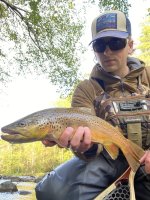Schaefer406
Active member
- Joined
- Jul 7, 2021
- Messages
- 249
It has been a bit since I have posted on here!
I have been getting out when I can, and have recently started to almost strictly use tightline to an indicator. I am currently using a mono rig with a 15 lb butt section --> 12 lb --> 10 lb sighter. For my current system, I have mostly been using a foam indicator right above my bottom tippet ring (smaller size - think Oros), or will use a Dorsey on lower and clearer waters. I have found this to be my go to rig due to being able to reach over currents, better drifts, longer drifts, and easier depth control. Being able to cast upstream further has been highly beneficial, similar to "floating the sighter" except you are getting much better control as you recover line. I also will use a lighter mono rig with this tactic for more sensitivity, strike detection, and easier "lift" when the indy is across current seams.
So - My question for those who fish a similar rig, what are your favorite alterations/additions to a tightline rig that you have found beneficial in controlling your drifts, getting better drifts, or for reaching over current? This can be anything ranging from additions to the leader build (backing barrel, applying wax to leader, etc.) or tactics you like to use when fishing mono.
I think a lot of people largely overestimate how spooky fish are when it comes to indicators. I also think a lot of people are way too confident that they are getting a dead drift when they really aren't, and are sacrificing catching fish at the cost of "using the popular rig" aka pure tightlining.
Recent fish pictures attached for your viewing pleasure.
I have been getting out when I can, and have recently started to almost strictly use tightline to an indicator. I am currently using a mono rig with a 15 lb butt section --> 12 lb --> 10 lb sighter. For my current system, I have mostly been using a foam indicator right above my bottom tippet ring (smaller size - think Oros), or will use a Dorsey on lower and clearer waters. I have found this to be my go to rig due to being able to reach over currents, better drifts, longer drifts, and easier depth control. Being able to cast upstream further has been highly beneficial, similar to "floating the sighter" except you are getting much better control as you recover line. I also will use a lighter mono rig with this tactic for more sensitivity, strike detection, and easier "lift" when the indy is across current seams.
So - My question for those who fish a similar rig, what are your favorite alterations/additions to a tightline rig that you have found beneficial in controlling your drifts, getting better drifts, or for reaching over current? This can be anything ranging from additions to the leader build (backing barrel, applying wax to leader, etc.) or tactics you like to use when fishing mono.
I think a lot of people largely overestimate how spooky fish are when it comes to indicators. I also think a lot of people are way too confident that they are getting a dead drift when they really aren't, and are sacrificing catching fish at the cost of "using the popular rig" aka pure tightlining.
Recent fish pictures attached for your viewing pleasure.







